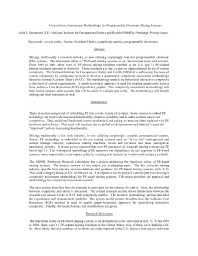Mining Publication: A Complexity Assessment Methodology for Programmable Electronic Mining Systems
Original creation date: August 2002
Mining, traditionally a low-tech industry, is now utilizing surprisingly complex programmable electronic (PE) systems. The functional safety of PE-based mining systems is an international issue and concern. From 1995 to 2001, there were 11 PH-related mining incidents reported in the U.S. and 71 PH-related mining incidents reported in Australia. These incidents are due, in part to unprecedented levels of system complexity. The National Institute for Occupational Safety and Health (NIOSH) is addressing this issue of system complexity by conducting research to develop a quantitative complexity assessment methodology based on Normal Accident Theory (NAT). The methodology models the behavioral interactive complexity at the level of system requirements. A graph-theoretical approach is used for creating quantitative metrics from Software Cost Reduction (SCR) dependency graphs. This complexity assessment methodology will help realize simpler, safer systems that will be easier to validate and verify. The methodology will benefit mining and other industries as well.
Authors: JJ Sammarco
Conference Paper - August 2002
NIOSHTIC2 Number: 20023439
Proc 20th Int Sys Saf Conf, August 5-9, 2002, Denver, CO 2002 Aug :177-186
See Also
- Addressing the Safety of Programmable Electronic Mining Systems: Lessons Learned
- Programmable Electronic and Hardwired Emergency Shutdown Systems: A Quantified Safety Analysis
- Programmable Electronic Mining Systems: Best Practice Recommendations (In Nine Parts): Part 1: 1.0 Introduction
- Programmable Electronic Mining Systems: Best Practice Recommendations (In Nine Parts): Part 3: 2.2 Software Safety
- Programmable Electronic Mining Systems: Best Practice Recommendations (In Nine Parts): Part 4: 3.0 Safety File
- Programmable Electronic Mining Systems: Best Practice Recommendations (In Nine Parts): Part 5: 4.0 Independent Functional Safety Assessment
- Programmable Electronic Mining Systems: Best Practice Recommendations (In Nine Parts): Part 6: 5.1 System Safety Guidance
- Programmable Electronic Mining Systems: Best Practice Recommendations (In Nine Parts): Part 8: 6.0 Safety File Guidance
- Programmable Electronic Mining Systems: Best Practice Recommendations (In Nine Parts): Part 9: 7.0 Independent Functional Safety Assessment Guidance
- Safety Framework for Programmable Electronics in Mining
- Page last reviewed: 9/21/2012
- Page last updated: 9/21/2012
- Content source: National Institute for Occupational Safety and Health, Mining Program


 ShareCompartir
ShareCompartir
